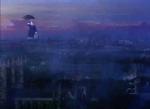

Musical.
A London banker and his suffragette wife are too busy to pay attention to their bored children, Jane and Michael. The family has its world turned upside down, however, by the irrepressible and nonsensical Mary Poppins, who teaches them how to enjoy life. Poppins is a kind of super-nanny who flies in with her umbrella in response to the request of the Banks children and proceeds to put things right with the aid of her rather extraordinary magical powers before flying off again. Jane and Michael experience a world of imagination in which people fly, carousel horses come alive, and tea parties are held on the ceiling.
This article investigates some possible terminology through an exploration of some of the twists and turns in the saga of Mary Poppins, and explores the explanatory potential of the horticultural metaphor of the rhizome.
 Saving Mr Banks
( dir. John Lee Hancock
)
United Kingdom (UK)
:
Ruby Films
Essential Media and Entertainment
Walt Disney Productions
,
2014
Z1854996
2014
single work
film/TV
Saving Mr Banks
( dir. John Lee Hancock
)
United Kingdom (UK)
:
Ruby Films
Essential Media and Entertainment
Walt Disney Productions
,
2014
Z1854996
2014
single work
film/TV
'Shifting back and forth between 1961 and 1907, this film tells the story of P.L. Travers (Pamela), the woman who created Mary Poppins. Framed by her experiences negotiating with Walt Disney and his team for the film of Mary Poppins, the main story of the film is of Pamela's childhood, in rural Queensland. Living in a small country town with a depressed mother and an alcoholic father, Pamela used her vivid imagination to create a richer, more welcoming environment for herself. From the characters of her childhood, and the worlds she invented, Pamela eventually created Mary Poppins, a character who has given pleasure to generations of readers and filmgoers, adults and children alike.'
Source: Essential Media Entertainment website, www.essential-media.com (sighted: 17/04/2012)
'The story behind the making of Mary Poppins is to be told in a Hollywood film starring Emma Thompson as Pamela Travers, the author who signed away the rights to Walt Disney only to regret it. Thompson is in negotiations to play Travers. The new film is to be titled "Saving Mr Banks", a reference to the Disney scriptwriters' attempts to write the character out of the story as they drifted from Travers' original plot. ' Anita Singh.